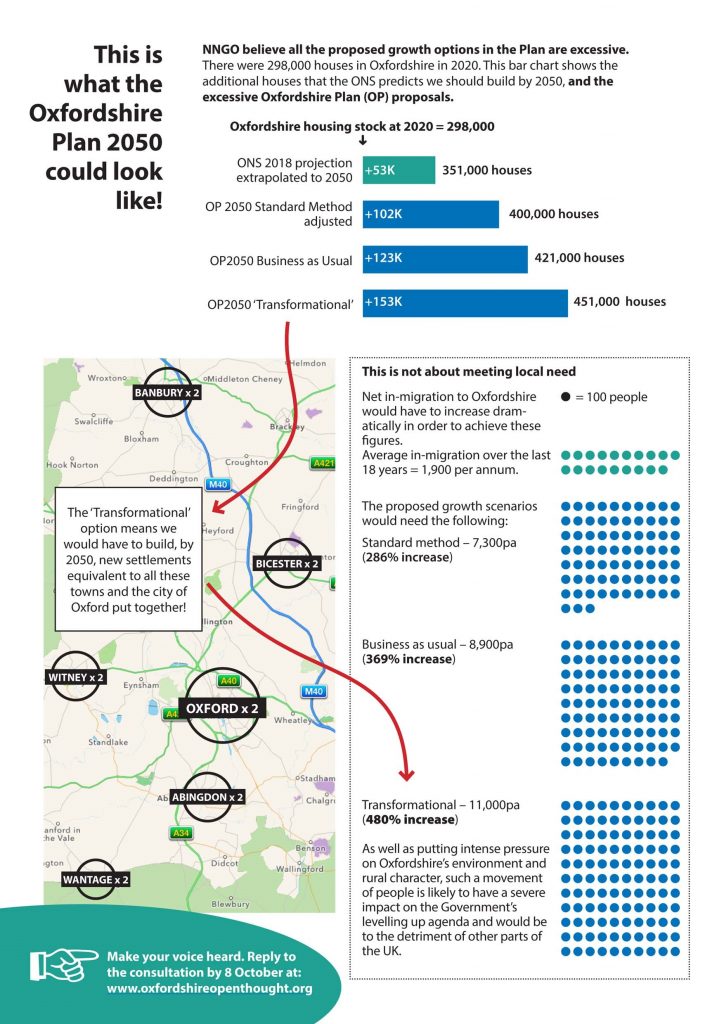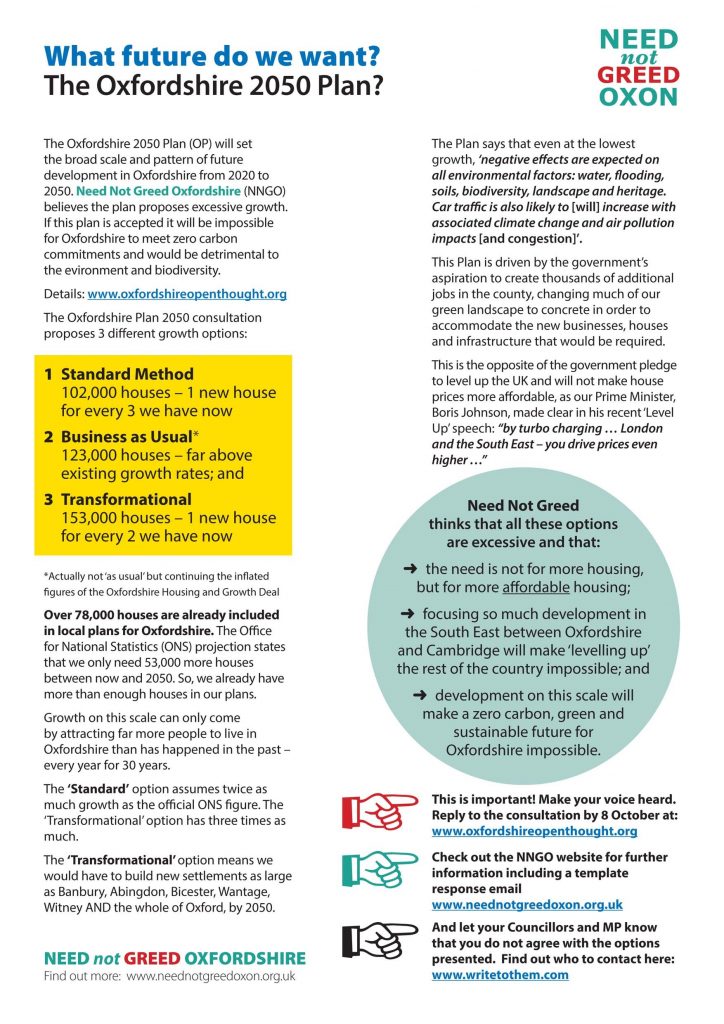Oxford City is consulting on future housing numbers. This will dictate levels of development not just in the City but in surrounding Districts too.
See: https://consultation.oxford.gov.uk/planning-services/oxford-local-plan-2040-reg-18-part-2-consultation/
Closes 27 March 2023.
We say “Need not greed should drive Oxfordshire’s future”
Oxfordshire Housing & Economic Needs Assessment – An NNGO Analysis
Oxford City Council’s approach is based on a new piece of work looking at future housing and jobs numbers, jointly commissioned with Cherwell District Council. The Oxfordshire Housing & Economic Needs Assessment (HENA, Dec 2022) has been produced by Cambridge Econometrics and Iceni, the very same organisations that previously drew up the deeply flawed ‘OGNA’ (Oxfordshire Growth Needs Assessment, July 2021).
- Left unchallenged, the HENA is likely to dictate housing numbers across the whole of Oxfordshire.
The City says it will be up to other local authorities whether or not to follow these figures. However, if they are agreed by a Planning Inspector and embedded in either the Oxford City or Cherwell Local Plans, then it may be very hard for Oxfordshire’s other local authorities to fight a rear-guard action against them. If these figures are to be challenged, then our local authorities must act NOW.
- These companies have a track record of over-estimating.
The ‘transformational’ figures in their previous analysis (the OGNA) suggested that the number of jobs in Oxfordshire would increase by 171,200 by 2050, we would need one new house for every two that we have now and around 11,000 net migrants into the County every year for 30 years. When NNGO questioned this assumption and the level of net migration assumed, we were dismissed. However, now this trajectory is rightly rejected in the HENA as being over-optimistic.
- The new projected growth figures are still wildly exaggerated.
Oxford City is proposing to use the trajectory underpinned by a special Cambridge Econometrics (CE) model outlined in the HENA. This puts the Oxfordshire-wide need at 4,406 dwellings per annum. This trajectory would expect to see Oxfordshire’s population growing by nearly 27% by 2040, compared to Office for National Statistics estimates of a UK population increase of less than 5%.
- The figures are not based on the Government’s Standard Methodology. They arbitrarily extrapolate conclusions from the 2021 Census.
NNGO agrees that the Census figures for Oxfordshire show that our population has grown faster than predicted (not surprising given the Oxfordshire Housing & Growth Deal, by which our local authorities agreed to a level of housing development well above local need). However, population figures are not the same as household projection figures. The Census indicated that household numbers in Oxford actually dropped slightly from 2011.
Our view is that the Government’s Standard Methodology remains the upper limit of what would be acceptable in terms of housing growth (3,388 dwellings per annum, compared to the 4,406 dpa proposed). Even this will place significant strain on our environment, services and infrastructure, and a trajectory based purely on meeting affordable housing need should be considered.
New standard methodology figures are expected in 2024, when the ONS’s household projection figures based on the 2021 Census are due to be published. Further census data still to be published also includes information on commuting, household formation and student numbers. Until then, a highly precautionary approach is required.
- The growth is based on carrying forward recent high levels of growth in perpetuity.
The population projections assume that comparatively high net migration rates into Oxfordshire during the five years 2015-2020 – 2,752 per year – will continue for the next 20 years. Given our current economic difficulties, this remains unlikely (see pt 2). It would certainly be more reasonable to base the projections on the ten-year period from 2010 to 2020 – this is 2,287 a year, 17% less.
- Overall, the HENA conclusions on growth are not compatible with the Oxfordshire Strategic Vision which commits all our authorities to planning for ‘good growth’ that is both sustainable and inclusive.
What is the associated carbon budget, both embedded and ongoing, for this level of growth?
What are the implications for Oxfordshire’s emerging nature recovery strategy?
How will off-loading growth onto surrounding Districts impact on the County’s Transport Strategy and the commitment to reducing car journeys?
Overall, the planned growth would have major consequences for Oxfordshire’s environment and quality of life and for the overall Levelling Up agenda, since it is based on pulling in migrants from less affluent parts of the UK.
What should happen now?
Our other local authorities (South Oxfordshire, Vale of White Horse and West Oxfordshire District Councils) must be prepared to engage robustly in the Cherwell and City local plan process. NNGO calls on them to immediately commission an independent review of the HENA and to set out their own alternative vision for sustainable housing growth in the county.
What can you do?
- Respond to Oxford City’s consultation – you can fill in the online survey or simply email planningpolicy@oxford.gov.uk
- Please alert your District/City Councillor to the dangers embedded in the HENA. If you live in Cherwell or the City, please ask them to reconsider their approach. If you live in one of the other Districts, please support them in making a robust challenge to the HENA growth agenda.
The template letters below may act as a guide but would be much better if put into your own words.
If you don’t know who your councillor is, then you can easily find out at www.writetothem.com
Template letter to Councillors
Template letter to Cherwell Councillors
Template letter to South Oxfordshire, Vale of White Horse, West Oxfordshire Councillors



